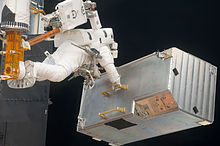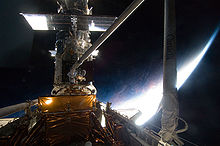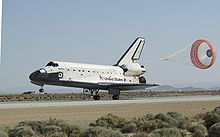STS-125
[1][9] The completion of all the major objectives, as well as some that were not considered vital, upgraded the Hubble telescope to its most technologically advanced state since its launch nineteen years before and made it more powerful.
"[14] Joining Mikulski as an advocate for servicing Hubble was NASA's Chief Scientist, physicist John Grunsfeld, who was present at the meeting when O'Keefe announced the cancellation of the mission.
[NASA 14] On August 22, 2008, after a delay following Tropical Storm Fay, Atlantis was rolled from the Orbiter Processing Facility to the Vehicle Assembly Building, where it was mated to the external fuel tank and solid rocket booster stack.
[42] Problems were encountered during the mating process, and poor weather due to Hurricane Hanna caused a delay in the rollout of Atlantis to the launch pad, which is normally done seven days after rollover.
[47] On October 30, 2008, NASA announced that Atlantis would be removed from its solid rocket boosters and external tank stack and sent back to the Orbiter Processing Facility to await a targeted launch time at 1:11 pm EDT on May 12, 2009.
[51] During the post-launch news conference, NASA managers said the initial early review of the launch video showed no obvious debris events, but a thorough analysis would be performed to ensure the orbiter sustained no significant damage during ascent.
[NASA 7][52] During the post-launch inspection of Launch Pad 39A, a twenty-five foot area on the north side of the flame deflector was found to have damage where some of the heat resistant coating came off.
[NASA 16][54] Mission managers called up to the crew to alert them of the find, advising Altman ("Scooter") that one of the orbiter's wing leading edge sensors recorded a debris event during ascent, around 104 – 106 seconds following liftoff, which may have been the cause of the damage seen in that area.
[NASA 18] Following the crew's post-sleep activities, they went to work performing the rendezvous operations that included burning the orbiter's engines to refine the approach to the Hubble telescope.
[56] Cain also noted that a debris event was recorded on the orbiter's wing leading edge sensors, but it was far below the force that would indicate a problem, and would not impact the mission.
After multiple attempts, managers on the ground decided to have Grunsfeld get a contingency torque limiter from the airlock, which would allow Feustel to apply more force without exceeding a specific point, but the bolt would still not release.
"[57] Following their wake up, the Atlantis crew set right to work preparing for the second spacewalk of the mission, with Massimino and Good suiting up with assistance from Grunsfeld and Feustel.
[59] While the spacewalk preparations were underway, Altman and McArthur completed a robotic survey of a small row of heat shield tiles that had not been sufficiently imaged during the day two inspection.
[NASA 20] The mission's second spacewalk officially began at 12:49 UTC, and the pair set to work removing and replacing the telescope's three gyroscope rate sensing units (RSUs).
[63] Flight controllers on the ground evaluated the consumables for the two spacesuits, and decided that if Massimino recharged his suit's oxygen in the airlock, the pair could safely continue with the battery installation.
[64] During the mission status briefing, Tomas Gonzalez-Torres, the Lead EVA Officer, and Hubble Program Manager Preston Burch both explained that the spare RSU would not impact the life of the telescope, as it had been fully refurbished on the ground with two of the three improvements incorporated in newer models.
[NASA 20] After awakening, the crew set to work preparing for the mission's third spacewalk, one that was considered the most challenging and uncertain, yet had some of the highest priority items scheduled.
[NASA 22][75] The procedure was tested at Goddard Space Flight Center prior to approving it, showing that the stripped bolt could be broken off safely using force.
[76] Massimino was instructed to return to the orbiter's airlock to retrieve a spare tool and to recharge his suit's oxygen reserves, to allow for completion of the STIS repair.
During the mission status briefing, Jennifer Wiseman, Chief of Exoplanet and Stellar Astrophysics for Goddard Space Flight Center, noted that the repair of STIS was a major victory for both the mission and the science community, as that part of the telescope performed unique functions, helping scientists understand the materials planets are composed of, and looking at things like the motion of stars around black holes.
[NASA 24] The twenty-third and final spacewalk to service Hubble brought the total time spent in EVA working on the telescope to one hundred and sixty-six hours, six minutes.
[22][81][82] The completion of all the major objectives, as well as some that were not considered vital, upgraded the telescope to its most technologically advanced state since its launch nineteen years ago, and made it more powerful than ever.
[11] Hubble's importance to science is not just seen in the dramatic images it provides, but also in the volume of work it has generated – an average of fourteen scientific articles are published each week based on data gathered from the telescope.
[85] Performing a small separation burn, Johnson backed the orbiter away from the telescope, and Altman called down to managers on the ground confirming the deployment of Hubble.
Using the robotic arm, McArthur, Altman, and Johnson worked through the procedures to inspect the wing leading-edge panels, reinforced carbon-carbon nose cap, and heat shield tiles.
[87][88] Obama told the crew, "Like a lot of Americans, I've been watching with amazement the gorgeous images you've been sending back, and the incredible repair mission you've been making in space," he said.
[89] Also late on Thursday, managers officially released Endeavour from its stand-by state, as Atlantis was cleared of any damage to its heat shield and was in good shape to return to Earth.
[NASA 31] After choosing to pass on the first opportunity for KSC and evaluate the second, managers on the ground decided that the weather in Florida was too dynamic to risk bringing the orbiter in, and opted to land at Edwards Air Force Base instead.
[1] Atlantis successfully landed at Edwards Air Force Base on Runway 22 at 8:39 am PDT after 197 orbits in space and a distance of approximately 5.2 million miles.
[2] Due to the inclination and other orbit parameters of Hubble, Atlantis would have been unable to use the International Space Station as a safe haven in the event of structural or mechanical failure.

























